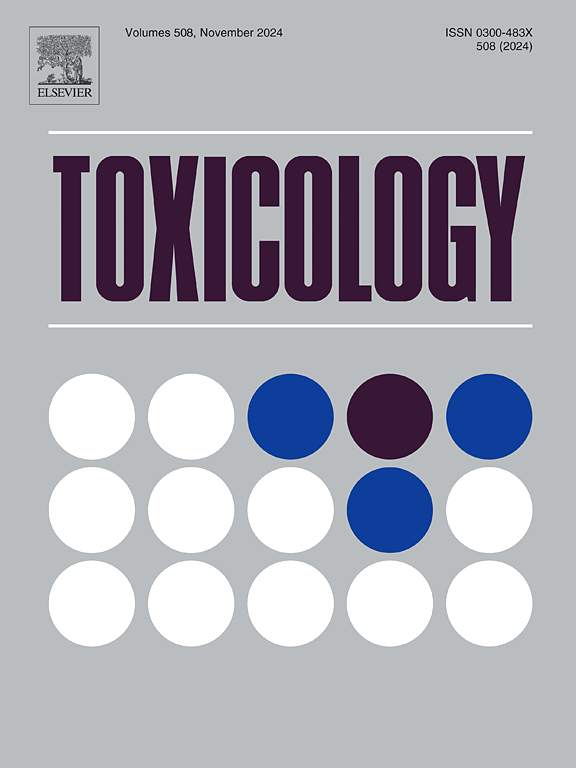6PPD通过ros介导的PI3K/AKT/mTOR通路诱导SH-SY5Y细胞凋亡和自噬:体外和体内方法
IF 4.8
3区 医学
Q1 PHARMACOLOGY & PHARMACY
引用次数: 0
摘要
N-(1,3-二甲基丁基)-N′-苯基-对苯二胺(6PPD)是橡胶材料中广泛使用的抗氧化剂,是一种新兴的污染物。6PPD已被证明具有潜在的神经毒性,对人体健康构成威胁。然而,对其神经毒性的研究仍然有限。本研究通过体外和计算机结合的方法,探讨了6PPD对SH-SY5Y细胞的神经毒性及其深入机制。我们的研究结果表明,6PPD可以通过增加活性氧(ROS)积累和改变谷胱甘肽(GSH)、过氧化氢酶(CAT)、超氧化物歧化酶(SOD)和丙二醛(MDA)的水平来降低细胞活力并引起氧化损伤。6PPD诱导线粒体通路神经元凋亡和自噬功能障碍,表现为Cleaved caspase-3、Bax/Bcl-2、Beclin-1、LC3-II/I、P62表达增加。6PPD下调PI3K、p-AKT和p-mTOR的表达,而PI3K抑制剂抑制PI3K/AKT/mTOR通路,促进细胞凋亡和自噬,表明PI3K/AKT/mTOR通路参与6PPD诱导的细胞凋亡和自噬。这一途径的抑制归因于SH-SY5Y细胞中的ROS积累。分子对接分析进一步发现,6PPD与PI3K、AKT、mTOR蛋白分子具有较强的结合亲和力,可有效干扰下游信号通路。这些发现丰富了对6PPD诱导的神经毒性的认识,并有助于评估与6PPD相关的生态风险。本文章由计算机程序翻译,如有差异,请以英文原文为准。
6PPD induces apoptosis and autophagy in SH-SY5Y cells via ROS-mediated PI3K/AKT/mTOR pathway: In vitro and in silico approaches
N-(1,3-dimethylbutyl)-N’-phenyl-p-phenylenediamine (6PPD), an extensively employed antioxidant in rubber materials, is considered as an emerging contaminant. 6PPD was proven to have potential neurotoxicity, which poses risks to human health. However, the research on its neurotoxicity is still limited. This work explored the neurotoxicity of 6PPD to SH-SY5Y cells and in-depth mechanisms with a combination of in vitro and in silico approaches. Our results indicated that 6PPD could reduce cell viability and cause oxidative damage by increasing reactive oxygen species (ROS) accumulation and altering the levels of glutathione (GSH), catalase (CAT), superoxide dismutase (SOD), and malondialdehyde (MDA). 6PPD induced neuronal apoptosis of mitochondrial pathway and autophagy dysfunction, as characterized by the increased expressions of Cleaved caspase-3, Bax/Bcl-2, Beclin-1, LC3-II/I, and P62. 6PPD downregulated the expression of PI3K, p-AKT, and p-mTOR, while the PI3K inhibitor suppressed PI3K/AKT/mTOR pathway and promoted both apoptosis and autophagy, indicating that PI3K/AKT/mTOR pathway was involved in 6PPD-induced apoptosis and autophagy. The inhibition of this pathway was attributed to ROS accumulation in SH-SY5Y cells. Molecular docking analysis further revealed that 6PPD exhibits strong binding affinity to PI3K, AKT, and mTOR protein molecules, which could effectively interfere with downstream signaling pathways. These findings enrich the understanding of 6PPD-induced neurotoxicity and contribute to the evaluation of ecological risks associated with 6PPD.
求助全文
通过发布文献求助,成功后即可免费获取论文全文。
去求助
来源期刊

Toxicology
医学-毒理学
CiteScore
7.80
自引率
4.40%
发文量
222
审稿时长
23 days
期刊介绍:
Toxicology is an international, peer-reviewed journal that publishes only the highest quality original scientific research and critical reviews describing hypothesis-based investigations into mechanisms of toxicity associated with exposures to xenobiotic chemicals, particularly as it relates to human health. In this respect "mechanisms" is defined on both the macro (e.g. physiological, biological, kinetic, species, sex, etc.) and molecular (genomic, transcriptomic, metabolic, etc.) scale. Emphasis is placed on findings that identify novel hazards and that can be extrapolated to exposures and mechanisms that are relevant to estimating human risk. Toxicology also publishes brief communications, personal commentaries and opinion articles, as well as concise expert reviews on contemporary topics. All research and review articles published in Toxicology are subject to rigorous peer review. Authors are asked to contact the Editor-in-Chief prior to submitting review articles or commentaries for consideration for publication in Toxicology.
 求助内容:
求助内容: 应助结果提醒方式:
应助结果提醒方式:


